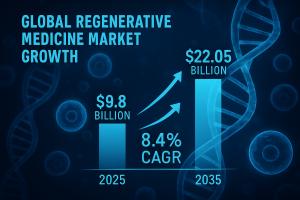Regenerative Medicine Market to Reach USD 22.05 Billion by 2035, Growing at 8.4% CAGR
Regenerative Medicine Industry Forecast: USD 22.05 Billion by 2035 with 8.4% CAGR
Get Sample Report: - https://www.futuremarketinsights.com/reports/sample/rep-gb-1326
The regenerative medicine market is transforming the landscape of modern healthcare by focusing on restoring the structure and function of damaged tissues and organs. This innovative field incorporates tissue engineering, cell therapy, gene therapy, and stem cell research to develop treatments that can replace or regenerate human cells, tissues, or organs. The ultimate goal is to create therapies that not only alleviate symptoms but also address the root causes of medical conditions.
What sets the regenerative medicine market apart is its broad potential across numerous therapeutic areas. From orthopedic injuries and cardiovascular diseases to neurological disorders and chronic wounds, the applications are vast. Advances in biomaterials and biocompatible scaffolds have further accelerated progress, opening doors to personalized medicine and improved patient outcomes. The industry continues to evolve rapidly, driven by technological innovations, increasing research funding, and the rising prevalence of chronic and degenerative conditions worldwide.
Market Trends
The regenerative medicine market is witnessing several transformative trends that are reshaping its trajectory. One of the most significant developments is the growing integration of artificial intelligence (AI) and machine learning in the design and testing of regenerative therapies. These technologies are enabling researchers to better understand complex biological interactions and accelerate the development pipeline.
Another notable trend is the increasing adoption of 3D bioprinting, which allows for the fabrication of tissue-like structures that closely mimic natural human tissue. This has tremendous implications for drug testing and potential organ replacement in the future. Meanwhile, stem cell therapies are gaining momentum, particularly in treating conditions like osteoarthritis, spinal cord injuries, and certain cancers. The use of mesenchymal stem cells and induced pluripotent stem cells is showing promise in clinical trials, contributing to a more robust regenerative medicine market.
Partnerships between biotech firms, research institutions, and healthcare providers are also on the rise. These collaborations are vital for translating laboratory research into practical therapies. Furthermore, regulatory agencies across the globe are gradually updating their frameworks to accommodate the unique nature of regenerative treatments, encouraging safer and more efficient pathways to approval.
Challenges and Opportunities
Despite its immense promise, the regenerative medicine market faces a variety of challenges. One of the primary concerns is the high cost of research and development. Creating, testing, and scaling regenerative therapies involve significant financial investments, and smaller firms often struggle with limited funding. Additionally, the complex regulatory landscape can delay the commercialization of innovative treatments.
Another key challenge is the variability in patient response. Regenerative therapies, particularly those involving stem cells, can behave unpredictably in different individuals, making it difficult to ensure consistent outcomes. This underscores the need for extensive clinical trials and personalized approaches.
However, the regenerative medicine market also presents substantial opportunities. As the global population ages, there is an increasing demand for treatments that address age-related diseases and improve quality of life. Regenerative medicine is ideally suited to meet this need by targeting the underlying mechanisms of tissue degeneration. Moreover, public and private investments in biotechnology are increasing, creating a more supportive environment for research and commercialization.
The growing interest in personalized medicine also aligns well with regenerative therapies, which can be tailored to an individual’s genetic and physiological profile. This convergence could lead to more effective and targeted treatments, reducing the burden on healthcare systems and improving patient outcomes.
Key Regional Insights
Geographically, the regenerative medicine market shows dynamic growth patterns across different regions. North America leads the industry, thanks to its well-established healthcare infrastructure, substantial research funding, and supportive regulatory environment. The United States, in particular, is home to many leading biotech companies and research institutions that are at the forefront of regenerative innovations.
Europe follows closely, with countries like Germany, the UK, and France investing heavily in regenerative research. The region benefits from collaborative efforts between academia, industry, and government agencies. Moreover, initiatives from the European Medicines Agency are streamlining approval processes, which is encouraging more innovation in the field.
Asia-Pacific is emerging as a strong contender in the regenerative medicine market. Countries such as Japan, China, and South Korea are witnessing rapid growth due to increased healthcare spending, a rising geriatric population, and strategic investments in biotechnology. Japan, in particular, has adopted progressive regulatory frameworks that facilitate faster approval of regenerative therapies, making it an attractive market for global companies.
Other regions, including Latin America and the Middle East, are gradually recognizing the potential of regenerative medicine and beginning to invest in research and infrastructure. While these markets are still in the early stages, they offer long-term growth potential due to their large populations and increasing disease burden.
Competitive Outlook
The regenerative medicine market is characterized by intense competition and constant innovation. Companies are racing to develop breakthrough therapies and secure market share in this rapidly expanding sector. Many organizations are focusing on specific niches, such as orthopedic regeneration, cardiovascular repair, or neurodegenerative disease treatment, to build specialized expertise and gain a competitive edge.
Strategic partnerships and mergers are becoming increasingly common as firms look to pool resources and accelerate development timelines. Collaborations between biotech companies, pharmaceutical giants, and academic institutions are particularly effective in bridging the gap between research and commercialization.
Intellectual property plays a critical role in the regenerative medicine market. Companies that hold patents for innovative techniques, cell lines, or biomaterials are in a strong position to influence market trends and attract investment. At the same time, open innovation models and data sharing are being explored to overcome barriers and speed up progress in the industry.
Explore In-Depth Analysis-Click Here to Access the Report:- https://www.futuremarketinsights.com/reports/regenerative-medicine-market
Top Companies
Several key players are leading the regenerative medicine market with their innovative approaches and robust product pipelines. Companies such as Organogenesis, Athersys, Inc., Vericel Corporation, and Mesoblast Ltd. have made significant contributions to tissue engineering and cell therapy. Their focus on clinical efficacy and scalability positions them well for long-term success.
Other notable companies include Medtronic and Smith & Nephew, which are leveraging their extensive medical device experience to develop regenerative solutions. Meanwhile, startups and smaller biotech firms continue to introduce disruptive technologies, challenging established players and driving competition.
Investment activity is robust, with venture capitalists and institutional investors showing keen interest in companies that demonstrate strong scientific foundations and commercial viability. These financial backing sources are essential in helping companies navigate the high costs associated with R&D and regulatory approval.
Segmentation Outlook
By Product Type:
• Cell Therapy (Autologous Cell Therapy and Allogenic Cell Therapy), Stem Cell Therapy (Allogeneic Stem Cell Therapy and Autologous Stem Cell Therapy), Tissue-engineering and Gene Therapy
By Application:
• Wound Care, Musculoskeletal Disorders, Oncology, Dental, DMD (Duchenne Muscular Dystrophy), Hepatological Diseases, Inflammatory & Autoimmune Diseases and Other Therapeutic Applications
By Region:
• North America, Latin America, Western Europe, Eastern Europe, East Asia, South Asia & Pacific, Middle East & Africa
Regenerative Therapy Industry Analysis Reports:-
Regenerative Medicine Market Size and Share Forecast Outlook 2025 to 2035
https://www.futuremarketinsights.com/reports/regenerative-medicine-market
Soft Tissue Repair Market Outlook from 2025 to 2035
https://www.futuremarketinsights.com/reports/soft-tissue-repair-market
Bone Regeneration Market Size and Share Forecast Outlook (2025 to 2035)
https://www.futuremarketinsights.com/reports/bone-regeneration-market
Regenerative Artificial Skin Industry Outlook from 2025 to 2035
https://www.futuremarketinsights.com/reports/regenerative-artificial-skin-market
Ankush Nikam
Future Market Insights, Inc.
+ +91 90966 84197
email us here
Visit us on social media:
LinkedIn
Facebook
YouTube
X
Legal Disclaimer:
EIN Presswire provides this news content "as is" without warranty of any kind. We do not accept any responsibility or liability for the accuracy, content, images, videos, licenses, completeness, legality, or reliability of the information contained in this article. If you have any complaints or copyright issues related to this article, kindly contact the author above.
A' International Computer Graphics, 3D Modeling, Texturing, and Rendering Design Awards Call for Nominations
A' International Product Engineering and Technical Design Awards Call for Entries
Technical Overview of the leagend TC101 Android Thermal Imager
Więcej ważnych informacji
 Jedynka Newserii
Jedynka Newserii

 Jedynka Newserii
Jedynka Newserii

Bankowość

Rośnie liczba i wartość udzielonych konsumentom kredytów gotówkowych. Gorzej mają się kredyty ratalne oraz te udzielane firmom
Rynek kredytowy w Polsce co do zasady rośnie, choć nierównomiernie. Z danych Biura Informacji Kredytowej wynika, że najlepiej rozwija się segment kredytów gotówkowych dla konsumentów. Wartościowo wzrosła też kwota udzielonych limitów w kartach kredytowych. Według prognoz BIK w całym roku wzrośnie wartość zarówno udzielonych kredytów mieszkaniowych, jak i gotówkowych, choć tych pierwszych poniżej inflacji. Wcześniejsze cięcia stóp procentowych przez RPP nie zmieniły tej prognozy.
Transport
37,5 proc. środków z Planu Społeczno-Klimatycznego trafi na walkę z ubóstwem transportowym. Organizacje branżowe apelują o zmianę priorytetowych projektów [DEPESZA]

Ministerstwo Funduszy i Polityki Regionalnej z końcem czerwca zakończyło konsultacje Planu Społeczno-Klimatycznego, który otwiera drogę do pozyskania 65 mld zł (11,4 mld euro) z unijnego Społecznego Funduszu Klimatycznego. Polska będzie jego największym beneficjentem, a 37,5 proc. budżetu zostanie przeznaczone na bezpośrednie wsparcie osób narażonych na ubóstwo transportowe. Organizacje branżowe oceniają jednak, że walka z tym zjawiskiem może się okazać nieskuteczna. W toku konsultacji zgłosiły swoje zastrzeżenia co do priorytetów w wydatkach i sposobu wsparcia inwestycji w transport rowerowy.
Prawo
Firmy będą mogły przetestować krótszy tydzień pracy z rządowym wsparciem. Nabór wniosków ruszy w sierpniu

Ministerstwo Rodziny, Pracy i Polityki Społecznej uruchamia pilotaż krótszego tygodnia pracy. Zainteresowane wzięciem w nim udziału firmy będą się mogły ubiegać o wsparcie finansowe ze strony rządu. Politycy Nowej Lewicy, którzy są pomysłodawcami testu tego rozwiązania, przekonują, że finalnie zyskają na nim wszyscy, zarówno pracownicy, jak i pracodawcy, a ostrzeżenia o spodziewanych problemach gospodarki są mocno przesadzone.
Partner serwisu
Szkolenia

Akademia Newserii
Akademia Newserii to projekt, w ramach którego najlepsi polscy dziennikarze biznesowi, giełdowi oraz lifestylowi, a także szkoleniowcy z wieloletnim doświadczeniem dzielą się swoją wiedzą nt. pracy z mediami.

![37,5 proc. środków z Planu Społeczno-Klimatycznego trafi na walkę z ubóstwem transportowym. Organizacje branżowe apelują o zmianę priorytetowych projektów [DEPESZA]](https://www.newseria.pl/files/1097841585/rower3,w_85,_small.jpg)







.gif)

 |
| |
| |
|